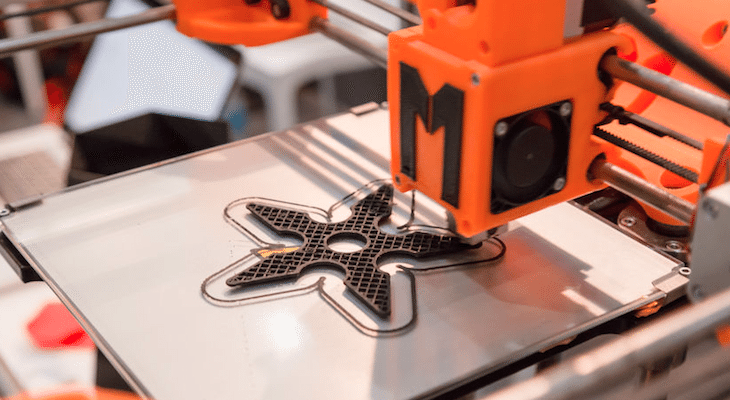3-D printing is revolutionizing manufacturing and the biggest breakthroughs are still to come. This fall, a team of Pennsylvania State University researchers announced they had developed a beam-scanning technique that can make 3-D printers print 1,000 times faster than they do today. The technique uses a heated crystal made of potassium tantalate and potassium niobate to accelerate the 3-D printing process from microseconds to nanoseconds. This allows products currently requiring an hour to 3-D print to finish printing in one minute, while 20,000 2-D pages can now be printed in the same amount of time.
This points to the explosive potential this type of printing represents for small businesses. The impact of this will be felt in the near future, but 3-D printers are already bringing big benefits to startups.
Bringing 3-D printing to small businesses
One of the most important developments in 3-D printing has been the emergence of affordable printers and printing services. While many desktop 3-D printers are over $2,000 and some models cost as much as $800,000, thanks to advances in technology, some budget 3-D printers are now available for as low as $250.
3-D printing prices will continue to fall at a rate of 6.1 percent over the next three years, IBISWorld forecasts.
Perhaps more significantly, 3-D printing as a service is now also available at an affordable price even for companies that do not own their own printing equipment. Many startups have entered this emerging field and have carved out niches specializing in specific areas of 3-D printing. Online 3-D printing services are now so plentiful that a review by All3DP includes no less than 27 different services specializing in materials ranging from thermoplastics to metals, nylon and even wood and glass. There are hundreds of 3-D printing fabricators operating in the United States alone, according to John Hornick, author of “3-D Printing Will Rock the World.”
In addition to these dedicated 3-D printing services, many manufacturers in specific industries now offer 3-D printing. For instance, o-ring manufacturer Apple Rubber will print products in any materials based on digital plans supplied by clients.
Related: Innovation vs. Emulation
Streamlining prototyping
3-D printing has also revolutionized prototyping. For startup companies and small businesses, one barrier to entering the marketplace has been the high cost of producing prototypes. The falling cost of 3-D printers and printing has driven this cost down by enabling companies to affordably print prototypes from any material, including cheaper materials than the end-product will require in actual production.
For instance, spoon manufacturer Spuni now prints its prototypes for $5 a piece using a 3-D printer that costs $2,000. Without 3-D printing, prototypes would cost $50 a piece using a traditional manufacturer, according to Spuni CEO Marcel Botha. Amazon is using a 3-D printing plant as an affordable way to test out designs for its fleet of drones, illustrating a strategy smaller companies can emulate (especially if Amazon rolls out 3-D printing as a service).
Improving agility
3-D printing is also giving small businesses more agility. The ability to rapidly produce prototypes allows small businesses to enter emerging markets quickly, getting a jump on the competition. 3-D printing also enables companies to scale production to actual demand, imparting more flexibility to adapt to market conditions. For instance, plastic injection mold manufacturer TriPro Technologies now uses 3-D printing to produce manufacturing aids on demand for clients. One client needed a camera support that would have taken too long to make out of aluminum and stay on schedule, so TriPro made a support out of Acrylonitrile Butadiene Styrene instead.
Related: Sign up to receive the StartupNation newsletter!
Personalized marketing
3-D printing is making it easier for small businesses to deliver customized products, improving their ability to deploy personalized marketing. For example, the printing service Shapeways prints products for clients based on digital models and then handles shipping fulfillment to the client’s customers. Clients can order personalized products for individual customers as well as mass-produced products. Products can be printed from plastic, porcelain, aluminum and precious metals. For instance, a jeweler can order a customized gold engagement ring based on a couple’s design, and Shapeways can then print it for the jeweler.
One of the most important applications of this type of technology is in the health care industry, where prosthetic devices such as artificial hands and feet can now be 3-D-printed to meet the personal body dimensions of patients, providing a smoother fit. A pair of students gained widespread publicity when they used this technological to print an artificial wheelchair for a kitten with no back legs. One team of surgeons used a 3-D-printed model as a replica for visualizing how to perform surgery on a girl who was otherwise inoperable, and some companies are now working on 3-D-printing artificial hearts and other organs geared toward the needs of specific patients.
In a similar way, startups and small businesses can now offer 3-D-printed products tailored to meet the specific needs of their customers.






